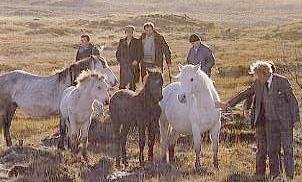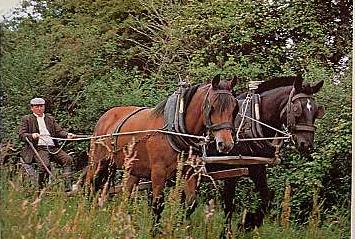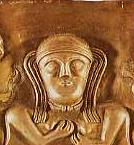|
The
Province of Connacht
|
||
|
The combined 4 Province
flag.
 |
The People | Climate | Economy | History |
The Flag of Connaught.
 |
| Counties
in the province of Connaught. The name means 'Conn's place.' |
||||
| Name | Irish Equivalent | County Town | Area km2 |
Area
sq miles |
| Galway | Gaillimh | Galway | 6148 | 2374 |
| Leitrim | Liatroim | Carrick-on-Shannon | 1588 | 603 |
| Mayo | Maigh Eo | Castlebar | 5585 | 2156 |
| Roscommon | Ros Comán | Roscommon | 2547 | 983 |
| Sligo | Sligeach | Sligo | 1836 | 717 |
The
People. |
||
| Irish customs and traditions have generally survived longer in Connacht than elsewhere in the country. Many people use the Irish language in everyday speech in the Gaeltacht areas, occupying parts of west Galway and Mayo, .a few of the older people on the islands may not speak English at all, outside the Gaeltacht English is the everyday language. The population of Connaught is now only two thirds of its level in the 1840's prior to the famine. Connacht has six parliamentary constituencies, which elect 21 members to Dail Eireann (the lower house of the Irish parliament). Local government is administered by five county councils, the county borough corporation of Galway, and the borough corporation of Sligo. |
||
|
|
Economy. |
||
| More than one
quarter of the working people of Connacht are employed in agriculture.
About one third of the farms are small, located on mountains and peat
bogs unsuited to agriculture. Much of the farmland with the exception
of parts of the east is not fertile, and best used for grazing livestock.
Beef cattle production is the principal type of farming in all counties,
with some dairying. There are modern factories in many towns throughout Connacht. Galway is the main industrial center, Sligo also has a considerable number of modern industries. A wide range of manufactured goods is produced in Connacht, but the most common industry is light engineering. Others include chemicals, food processing, printing, textile and clothing manufacture, and wood products. In recent years computer based industries have been established mainly around the Galway area. Nearly half of the people of Connacht work in service industries. The main types are retailing, education, health services, public administration, and transport. Tourism is employing an increasing number of people. There is a university college in Galway and regional technical colleges in Galway and Sligo. Tourism is a growth industry and an important source of income, especially in coastal areas. Salthill, a seaside suburb of Galway, is the main resort. The excellent angling on rivers and lakes also attracts a large number of visitors from the UK and Europe. Commercial fishing is important in several coastal districts, especially in County Galway, many of the larger trawlers venturing out to the Porcupine bank on the edge of the continental shelf, in search of the deep water prawns. People with smaller boats combine fishing with farming as a means of earning a living, fishing crabs and lobsters in season, and in some cases drift netting for salmon, a traditional activity which is frowned upon by the angling fraternity. The area given over to forestry has increased greatly, much of it in upland and peat bog areas. There is also extensive peat cutting. Marble is quarried in County Galway, its distinctive colour to be seen in the many craft shops in the area. Transport in Connacht is mainly by road. The principal routes are those running eastward toward Dublin from Sligo (the N4), Castlebar (N5), and Galway (N6). A national primary route, the N17, also runs from north to south through Connacht. Railways run to Dublin from Galway, from Westport and Ballina, and from Sligo. Galway city is the main seaport. Horan International Airport is near Knock, in County Mayo. There are smaller airports near Galway, Sligo, and Castlebar, and sea and air services to the Aran Islands. |
||
|
|
The
Land. |
||
| Most of Connacht lies to the west of the River Shannon. To the east is Leinster, to the south is Munster, and to the north is Ulster. The western seaboard is long and in places deeply indented by the Atlantic ocean. Offshore islands include the Aran Islands off County Galway and Achill Island off Mayo. Connacht occupies one quarter of the area of the Republic of Ireland. It measures about 140 kilometers from north to south and about 160 kilometers from east to west. The magnificent wild grandeur of the area is manifested in the extensive areas of mountains and peat bogs lying in the west and north of Connacht. These are generally regarded as the most attractive parts of the province. Much of the remainder lies in the more fertile central lowlands, where the underlying rock is limestone. Most of the eastern portion of Connaught is drained by the River Shannon, which flows through lakes Allen, Ree, and Derg, reaching the sea at Limerick which is some 70 Kilometers inland at the head of the Shannon estuary, about half way down the estuary is the deep water port of Foynes. The Shannon waterway is a deservedly popular area for inland cruising, from it you could cruise north to Lough Erne, east through the midlands to Dublin, and south to Waterford. The west of Connaught is drained by the rivers Corrib and Moy. Lough's Corrib, Mask, and Conn lie along the edge of the western uplands. |
||
|
|
The
Climate |
||
| Connacht enjoys a mild and moist climate with winds blowing in from the Atlantic Ocean. The average temperature in July is about 15 °C, but in January it varies from about 4.5 °C in the northeast to over 6 °C along the west coast. Annual rainfall rises from 100 centimeters in the lowland east to more than 200 centimeters on the mountains of the west. Even on the lowlands, rain falls on between 170 and 200 days each year. |
||
|
|
History.
|
||
| People have
settled in Connacht since Stone Age times, ancient monuments are especially
common in Sligo and north Mayo, it was in the latter the remains of
one of the largest stone age agricultural farming systems in Europe
has been uncovered, known as the Ceide
Field's a visitor center After the Anglo-Norman invasion of the 1200's,
much of Connacht was ruled by Richard de Burgo. The earliest towns date
from this period. Connacht long remained one of the most Gaelic areas
in Ireland, its rugged land less fertile than that of the east being
less attractive to the successive bands of invaders. In the 1600's,
it became a refuge for homeless persons displaced from the east of the
country during the Cromwellian invasion. Connaught was one of the worst
affected areas during the Great
Famine of 1845-1847. In 1879, some children in the tiny village
of Knock in county Mayo claimed to have seen visions of the Virgin Mary.
Since then Knock has become a place of pilgrimage for Roman Catholics
from all over the world, a shrine and visitors
center was built, and as a result of a campaign by Monseigneur Hornan
an airport was built near Knock, adding greatly to the prosperity of
the area. |
||
|
|
| |

 The uplands are suitable only
for sheep, although depending on the financial climate prevailing, parts
of the lowlands are used for sheep production also. It is estimated
that only about 3 per cent of farmland is used to grow arable crops,
these being mainly barley, oats, and potatoes.
The uplands are suitable only
for sheep, although depending on the financial climate prevailing, parts
of the lowlands are used for sheep production also. It is estimated
that only about 3 per cent of farmland is used to grow arable crops,
these being mainly barley, oats, and potatoes.  has been
built on the site. Connacht was one of the ancient kingdoms of Ireland.
One of its most famous legendary rulers was
has been
built on the site. Connacht was one of the ancient kingdoms of Ireland.
One of its most famous legendary rulers was